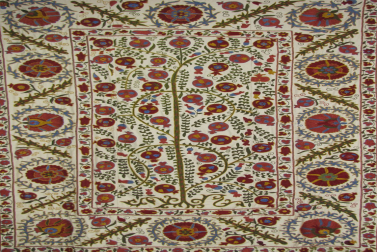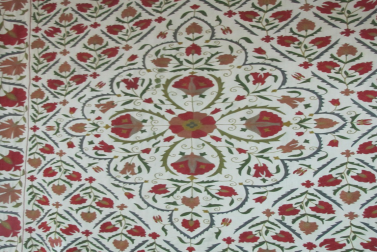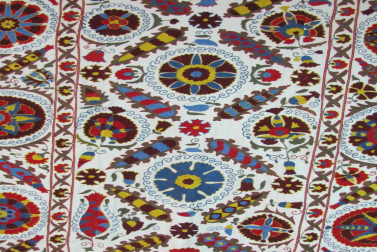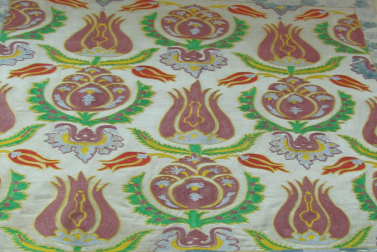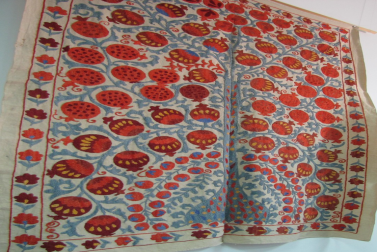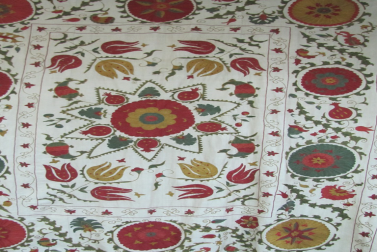Uzbekistan’s Intangible Cultural Heritages : Miniature Art
The tradition of Uzbekistan's miniature paintings include
gold embroidery, skullcap embroidery, Nurota embroidery, wood carvings, Ganch carvings and artistic ceramic.
The tradition of Uzbekistan's miniature paintings include
gold embroidery, skullcap embroidery, Nurota embroidery, wood carvings, Ganch carvings and artistic ceramic.
From ancient times, Uzbek people were famous for being well-versed in the arts.
Paintings especially were highly appreciated, and people showed highest respect to the artists.
The paintings demonstrate the beauty of humanity through the centuries, and a particular kind of work, miniature
art, has evolved and developed through the centuries.
The delicateness and complexity of miniature art requires artists to put in intense hours for labor and research.
The master should possess the knowledge and skills, as well as attention to detail, to create masterpieces which describe
nature, people and animals, emphasizing the beauty that is not easily noticed at first glance
Uzbekistan's tradition of miniature painting itself is an intangible cultural heritage, and at the same time,
one can discover Uzbekistan's other intangible cultural heritage elements in the paintings.
Gold embroidery, or Zardozlik, is one of the most ancient types of
Uzbekistan’s handicraft art. In Farsi, Zardozlik means gold (“zar”) sewing (“dozi”).
Zardozlik was mainly done in the region of Bukhara.
Gold embroidery was done on fabrics such as velvet, silk, cloth and leather,
and are embroidered with images of flowers, geometric patterns or a picture, with golden or silver thread.
Sometimes, beads made of metal, stone or glass are also used
In forming shapes, zardozi, zamindozi, guldozi, birishdozi and pulakdozi styles are mainly used. Among the handasa patterns, davqur, darham, donacha, bodomiy, and butador are considered to be the most beautiful.
Gold embroidery is mainly done with hoops, scissors, thimbles and needles. Fabrics such as velvet, imported or local silk, satin, muslin, broadcloth, wool, leather and alocha, a local half-silk fabric, were used, with various types of metallic threads.
In Turkish language, Doppi means “high” or “ledge”.
From one region to another, Doppi differs in terms of form and decor. For example, in the region of Surkhandarya, people call Doppi as a cap, people of the Lokay tribe call it “takya” or “takiya”, but Khorezm people call it “takhya”.
Doppi is a very valuable piece of clothing, considered to be above other items.
The creation of the Doppi dates back to ancient history. Skullcaps can be found on statues, coins and miniature paintings from the middle ages.
Skullcaps are made predominantly by women. Each craftswoman has her unique patterns for her skullcaps.
Therefore, each Uzbek skullcap is different, decorated with roses, carnations, blue flags, tulips, quail grass, almonds, peppers, almond flowers, peacocks, cocks and parrots.
Carving is an ancient and widespread type of practical art, which makes artistic forms by carving and cutting wood, ganch (plaster), metal, stone, bone, terra cotta and other materials.
There are different types, such as wood carving, ganch carving, metall carving and bone carving, depending on the raw material used.
The most distinguishing feature of this type of applied art in Uzbekistan is that masters (i.e. wood carvers) produced not only various household
items and goods, but also participated in creating carved wooden columns, doors and other elements of architectural significance.
Wide-scale application of carvings can be observed from wooden columns, doors and other architectural elements in the buildings in capital cities of Uzbek khanates, such as Khiva, Bukhara and Kokand.
Ganch (plaster) carving is a traditionally developed handicraft art, known for its artistic value.
It is used in decorating and plastering walls and ceilings, creating architectural details and creating decorative shapes, curved ornaments and images.
From time immemorial, it has been used for decorating palaces, madrasahs, mosques and residential houses of the rich.
Its main centres were located in Khiva, Bukhara, Tashkent, Samarkand, Andijan, Namangan and Kokand.
There are two types of decorating techniques used in creating Ganch carvings: Ganch decoration is carved directly on the plasterwork, or decorative features are installed on the walls and ceilings.
Using moulds to make the decorations enables the masters to create larger-scale decorations.
At present, Ganch Carving remains one of Uzbekistan’s most representative folk arts, and to this day, it is prominently used in designing architectural buildings.
Address95 Seohak-ro, Wansan-gu Jeonju, Jeollabuk-do 55101 Republic of Korea
Tel+82-63-230-9702FAX+82-63-230-9700
